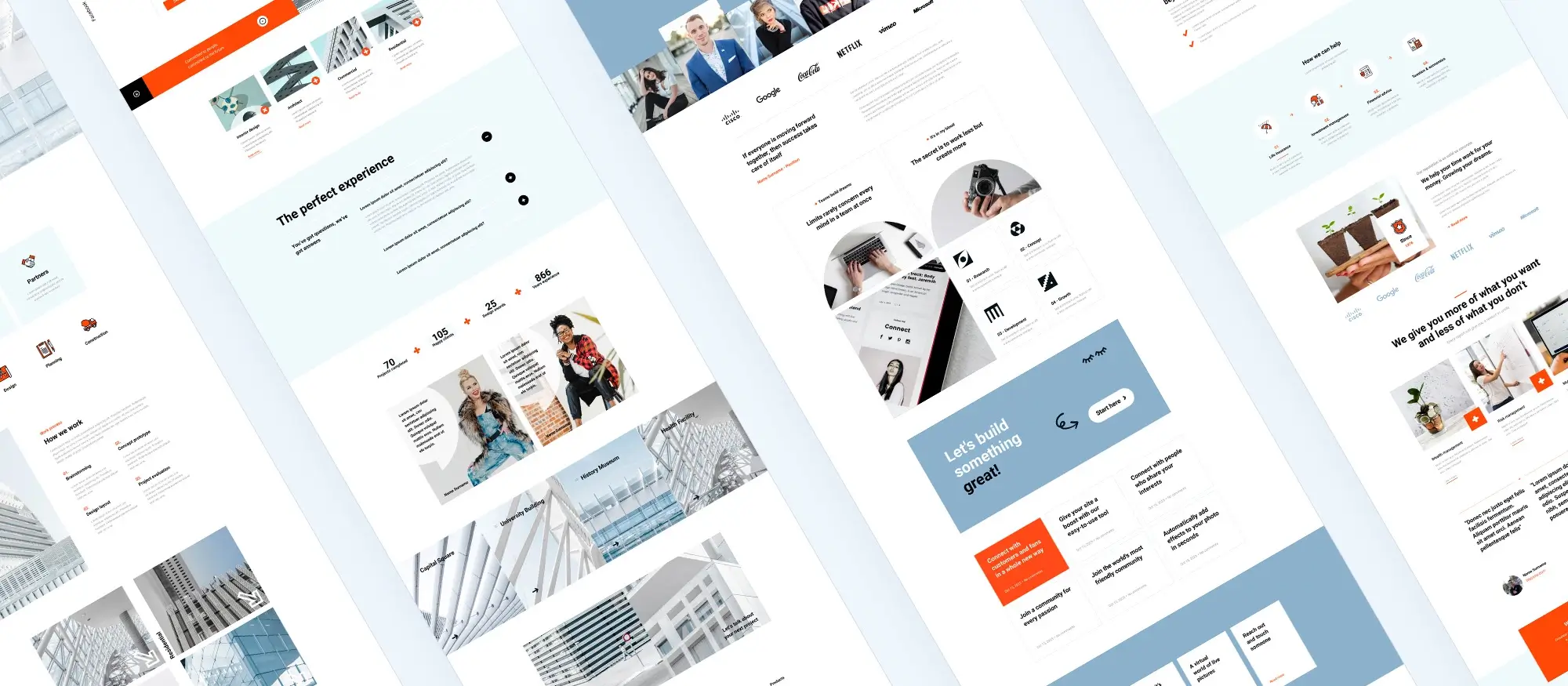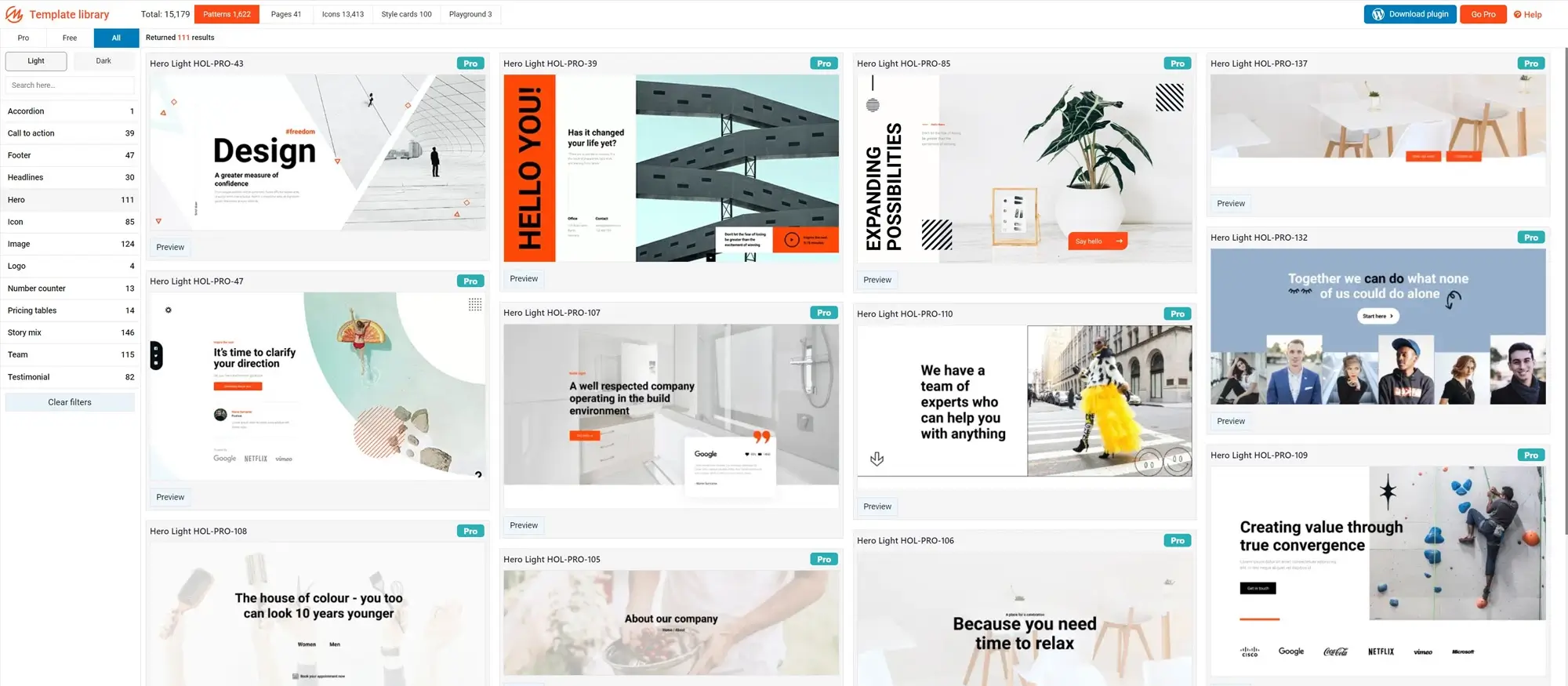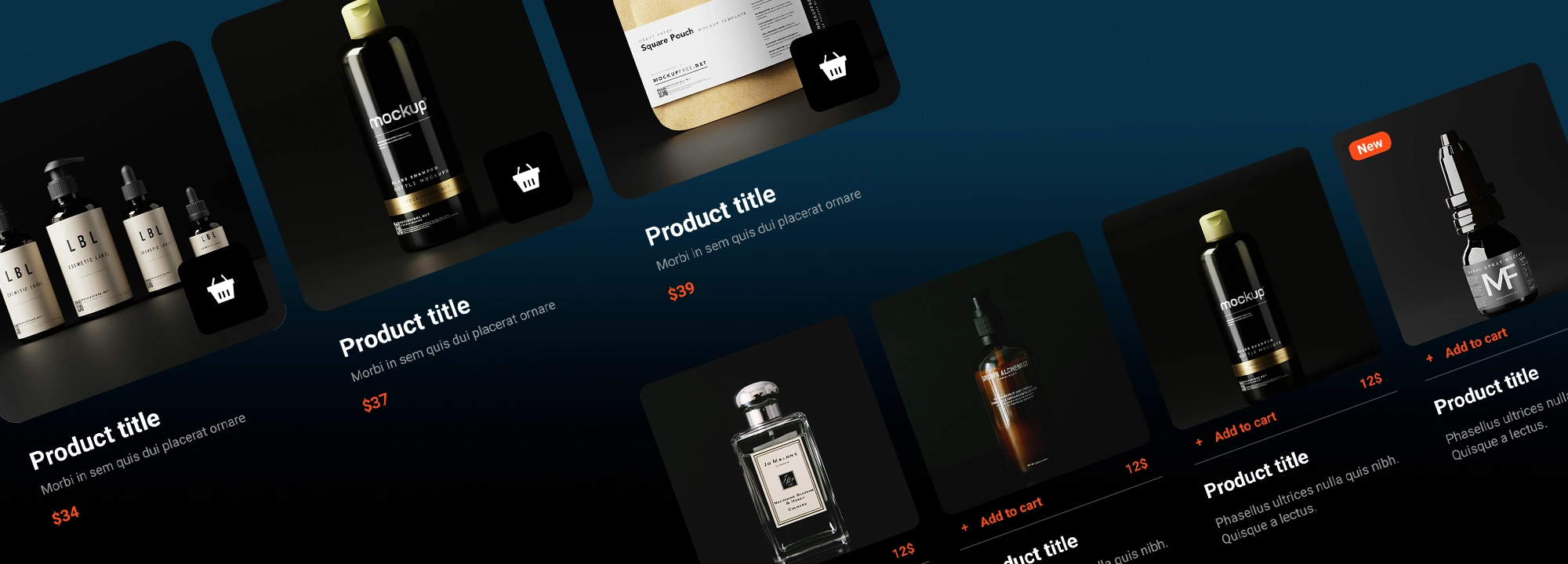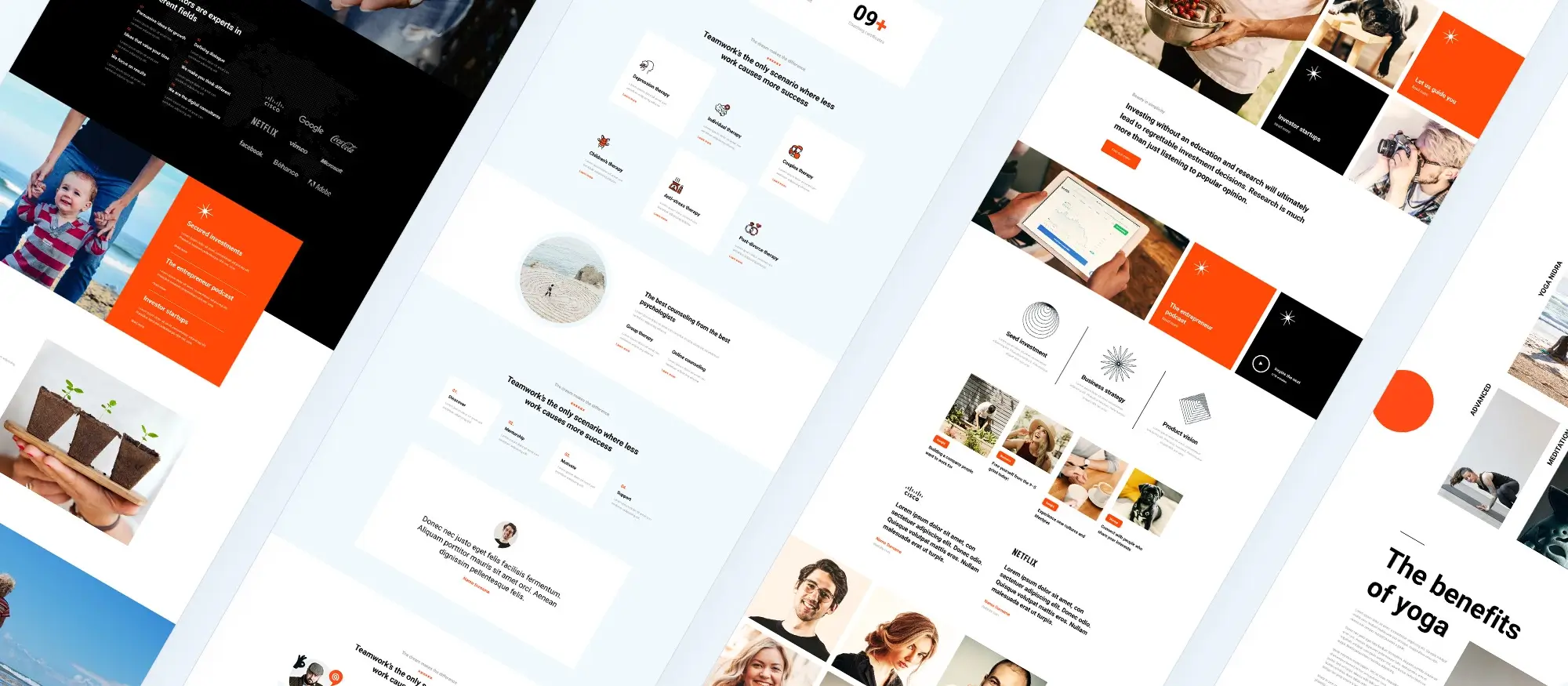Guide to WordPress templates, themes and page builders
Try MaxiBlocks for free with 500+ library assets including basic templates. No account required. Free WordPress page builder, theme and updates included.

Updated 8th May 2025
What are WordPress themes?
WordPress themes are pre-designed layouts that can be used to create a website. They add style to a site and designers can choose and download from websites that offer thousands of designs with a wide variety of features and customization options.
What is the difference between free and premium WordPress themes?
There is an easy distinction between free and premium WordPress themes. The free themes generally have no cost attached whereas premium themes do require the payment of a fee. Premium themes generally offer more features, customization options, and support from the developer than free themes. They also include premium-quality plugins and extensions, saving the users’ time and money on the search for third-party solutions.
What are some good free themes?
There are numerous free themes available that offer attractive designs and functionality. Here are some popular ones:
- Astra is a highly customizable and lightweight theme that provides a range of starter templates to choose from. It is compatible with popular page builders and offers seamless integration with WooCommerce.
- OceanWP is a responsive and feature-rich theme suitable for various websites. It offers a range of demo pages, excellent customization options, and compatibility with popular plugins.
- Neve is a fast and lightweight theme that works well for both personal and business websites. It offers a modern design, numerous customization options, and excellent performance.
- Hestia is a stylish one-page theme suitable for small businesses, startups, and creative professionals. It provides a modern and clean design, easy customization, and compatibility with popular page builders.
- GeneratePress is a lightweight and flexible theme that offers a solid foundation for any website. It provides a range of customization options, optimised code for faster loading times, and seamless integration with popular plugins.
- Zerif Lite is a clean and modern one-page theme ideal for small businesses and agencies. It features a parallax effect, a responsive design, and easy customization options.
- Sydney is a powerful business theme with a professional and elegant design. It offers customizable header options, full-screen sliders, and integration with popular plugins.
- ColorMag is a magazine-style theme suitable for online magazines, news websites, and blogs. It offers a vibrant design, multiple widget areas, and compatibility with popular plugins.

There are many premium WordPress themes available that provide advanced features, a wide range of customization options, and dedicated support. Some well-regarded premium themes include:
- Divi is a versatile and popular theme that comes with a powerful page builder and a vast library of pre-designed pages. It offers a drag and drop interface. The theme can adapt to different screen sizes and has and robust customization options.
- Avada is a best-selling multipurpose WordPress themes that offers a wide range of design options and flexibility. It comes with a fusion builder, multiple demo pages, and integration with popular plugins.
- X Theme is a highly customizable and responsive theme that offers multiple unique designs called “Stacks.” It provides a visual page builder, extensive customization options, and integration with popular plugins.
- The7 is a feature-rich and highly customizable theme suitable for various types of websites. It offers multiple design styles, a powerful theme options panel, and integration with popular page builders.
- The newspaper is a premium WordPress themes specifically designed for news, magazine, and publishing websites. It provides a modern and elegant design, numerous customization options, and dedicated features for content-heavy websites.
- Bridge is a versatile and creative WordPress themes that offers an extensive collection of demos and design options. It provides a visual composer, advanced customization options, and integration with popular plugins.
- Salient is a visually stunning and responsive theme suitable for creative professionals and businesses. It offers a range of pre-designed pages, a powerful page builder, and advanced customization options.
- Jupiter X is a highly customizable and fast WordPress themes that offers a range of pre-designed pages and customization options. It provides integration with popular plugins, a visual composer, and responsive design.
Advantages of premium themes, including additional features and support
Premium themes offer several advantages over free themes, including:
Additional features
Premium themes often come with a wider range of features and customization options than free themes. This can include advanced page builders, custom widgets, and pre-designed themes.
Dedicated support
Premium WordPress themes developers typically offer dedicated support to their customers. Support can provide good documentation, well explained tutorials and support forums. In addition the premium theme may come with email or onsite chat bots or humans.
Regular updates
Premium themes are usually updated more frequently than free WordPress themes. Regular updates keep the theme bug free and adapted to changing technology. WordPress themes need to be compatible with the latest WordPress version as well as work with other plugins installed on the site
Unique design
Premium themes often have a more unique and polished design than free WordPress themes. Websites made with the premium theme may be more attractive than free themes. Visitors to the site will also appreciate the good design.
Premium themes can provide a higher level of quality, functionality, and support than free themes. It’s important to do your research and choose a reputable theme developer before making a purchase.
Subscribe to our newsletter
Creating an engaging homepage is an important part of building a successful website
Visual page builders are plugins that can help designers easily build attractive websites. This applies to eCommerce sites as well. Page builder plugins provide an easy to use drag and drop interface. This allows designers to add and arrange design elements without the need for coding knowledge. Page builders offer various design elements and widgets. Web designers can use a range of features such as text, images, videos and forms to create unique web pages. Designers can choose from prebuilt themes or create their own layout using a grid system. Add the company logo and other branding elements to personalise the site.
Good navigation is great for a positive user experience, and page builders can help to create intuitive menus and navigation elements. Many page builders also come with a support team to help with any issues or info the designer may need. It is also possible to create responsive designs that look great on any device, including mobile devices.
A content management system
WordPress is a content management system. It is one of the most used CMS’s. The market is well served with customisable WordPress themes and plugins which are of great benefit for both beginners and experienced users.
It is possible to organise and publish content with ease. WordPress has a huge selection of plugins. The plugins are pre-made features that can add functionality to a site. There are plugins for everything. Whether a website needs SEO, a form or site security there is a plugin to assist with this functionality.

Overview of WordPress’s popularity and widespread usage
43.2% of all active websites worldwide use WordPress. Amongst other CMS options WordPress boasts 60.8% market share.
From blogging platform to a CMS
It was initially released in 2003 as a blogging platform, with a focus on making it easy for users to publish and manage their blog posts. However, over time, it has evolved into a versatile content management system (CMS) that can be used to create and manage all types of websites, not just blogs.
This evolution was made possible by the addition of new features and functionality to the core software, as well as the development of a vast ecosystem of WordPress themes and plugins that extend its capabilities. Today, it can be used to create everything from simple blogs to complex e-commerce websites, online communities, and more.
One of the key factors in this evolution has been the flexibility as a platform. Its modular architecture allows developers to easily add new features and functionality through the use of plugins, while its WordPress themes system allows designers to create custom layouts and designs for websites.It is also popular among top websites, powering 36.28% of the top 1 million websites, including big names like Bloomberg, Nike, and The New York Times. WordPress has posted the fastest growing statistics for 12 years.
What is a content management system (CMS)
Manage the content of a website easily by using content management software. Web designers without technical knowledge are able to change and publish digital content. A CMS provides a user-friendly interface for organising and editing content, as well as tools for managing the design and functionality of a website.
As a CMS, it is used by many personal blogs, online stores, and other types of websites. It is known for being SEO-friendly and offers many WordPress themes and plugins, including full-width pages and e-commerce plugins.
The Open-Source nature and community-driven development
This software adopts an open source model, making its source code readily accessible for review and modification. This allows for a global developer community to contribute to its evolution by implementing new features, addressing bugs, and optimising performance.
An enthusiastic community of developers and designers get together to work on improving the software. This community driven development ensures it remains compatible with current web standards and leverages cutting edge technologies.
Beyond the core software, community members create and share diverse WordPress themes and plugins to expand its functionality. This enables users to seamlessly integrate new features into their websites without requiring coding expertise.
The open source model and community driven development are instrumental in the software’s success and widespread adoption as a content management system.
Build like a pro
Here are some tips to help you find the right theme
When looking for a theme, it is important to consider the needs and the purpose of the website.
- Identify the needs: Consider the features and functionality that are important for the website. Will the site need to have an online store? Or perhaps the website will only be used for blogging. Knowing the purpose of the website will determine what WordPress themes is the most appropriate.
- Verify compatibility: Ensure the theme is compatible with the latest WordPress version.
- Consider support and updates: Look for WordPress themes that are regularly updated and have good support options. This will ensure that the website remains secure and will not break with future updates.
- Read reviews: Check out reviews from other users to see what their experience has been with the WordPress template. This can provide insights into its performance.
- Preview the template: Most WordPress templates offer a live demo or preview which makes it easy to see how it will function once live.
What is a multipurpose theme?
Multipurpose WordPress themes offer a versatile approach to website development, catering to a broad spectrum of project requirements. These themes stand out for their flexibility, allowing them to adapt to various website purposes, including blogs, portfolios, e-commerce stores, and business sites. By providing a comprehensive set of customization options, pre designed layouts, and built in features, multipurpose themes enable users to tailor the template to their specific needs. This eliminates the need to search for a new WordPress themes for each individual project, streamlining the development process and promoting consistency across multiple websites. In essence, they offer a cost-effective and efficient solution for creating professional websites with diverse functionalities.
How do I know if I have a well-designed and functional website and blog?
A well-designed website is easy to use, visually appealing, and performs well.
- Usability: A seamless user experience is paramount. Information architecture should be intuitive, guiding users to their desired content effortlessly. Well-structured navigation and a clear layout are crucial for efficient interaction.
- Visual Design: Cohesive aesthetic elements contribute to a positive impression. Colours, fonts, and images should be employed thoughtfully, adhering to a unified WordPress themes that aligns with your brand identity. Typography, particularly font choice and legibility, is essential for conveying your message effectively.
- Content Quality: Relevant, informative, and current content is vital. Concise and well-written text ensures clarity and engages your audience. Regular content updates demonstrate dynamism and value.
- Performance: Speed and responsiveness are crucial for user satisfaction. Optimise the website to load quickly and function flawlessly across diverse devices.
- Search Engine Optimization (SEO): Strategic incorporation of relevant keywords and adherence to technical best practices enhance search engine visibility. This increases the likelihood of users finding your website when searching for related topics.
Additional Considerations:
- Accessibility: Ensure your website is accessible to users with disabilities.
- Security: Prioritise robust security measures to protect user data and website integrity.
- Maintainability: Implement an efficient framework for updates and ongoing maintenance.
By addressing these core principles, you can create a professional website that delivers both a positive user experience and strategic value.
You may also want to include elements such as a default footer with links to your privacy policy and other important pages, integration with Google Maps or Twitter, and the use of HTML to structure your content.

Investing in website design
Why design matters
A well-designed website helps your business build trust, stand out from competitors, and support long-term growth. It turns visitors into customers and gives your brand a solid foundation online.
Ways to measure your site’s performance
Qualitative feedback
Ask real users for honest feedback through surveys or interviews.
Study competitor sites to get ideas and find gaps in your own.
Quantitative methods
- Use Google Analytics to track visitor behaviour and conversions.
- Try heatmaps or session recordings to see where users click or drop off.
- Run A/B tests on layouts, buttons, or headlines to see what works better.
How to choose the right theme
Define what you need
Think about your site’s goal, preferred layout, must-have features, and your industry.
Where to find themes
Browse the WordPress theme directory, check marketplaces, or explore community groups like WordPress-focused Facebook groups.
How to pick one
Read reviews, check when it was last updated, preview the demo, and install it on a test site before going live.
Final thoughts
You don’t need to overcomplicate your site to make it work. Start with the basics: choose a clean, responsive theme, install helpful tools, and focus on user experience. Use real data and feedback to make improvements. WordPress gives you room to grow, so keep it simple and build from there.
If you’re looking to streamline your next website build, WordPress block templates are a smart starting point. Whether you’re exploring business homepage templates, creating a photographer’s portfolio or launching a studio site, there’s a growing library of pre-designed layouts to match every project. At MaxiBlocks, you’ll find free WordPress templates along with dark mode designs for interior design, a clean acupuncture website template, and even niche styles like our concert theme and architectural layouts.
For a broader overview, start with our guide to WordPress block templates, then explore how to find the right WordPress template for your needs. You can also dive into the future of block templates and see how template libraries are evolving. If you’re comparing solutions, we cover everything from basic block templates to social media-ready layouts, and explain how themes and templates work together on your WordPress site. Whether you’re browsing WordPress website templates, design-focused themes or general site templates, our goal is to make professional, fast-loading sites easier to launch with the power of block-based design.
WordPress template sites for fast and easy design
Explore flexible WordPress templates with built-in styles and block layouts for faster design.
FAQs – Guide to WordPress templates, themes and page builders
What is the difference between a WordPress theme and a template?
A WordPress theme controls your site’s overall design, while a template refers to a specific page layout used within that theme, like for blog posts or contact pages.
What are WordPress block templates?
Block templates are full-page layouts made of pre-arranged blocks you can use and customise in the WordPress block editor.
How do templates differ from block patterns?
Templates structure entire pages, while block patterns are reusable sections like headers or call-to-actions you can insert anywhere on a page.
What is a WordPress page builder?
A page builder is a drag-and-drop tool that lets you create custom layouts in WordPress without coding.
Do I need a page builder if I use block themes?
Not always. Block themes offer layout flexibility through the Site Editor, but page builders still offer more design tools and control if needed.
Are free themes good enough?
Yes, many free themes are high quality and offer great design and performance. Just check for good reviews and active updates.
How do I install a WordPress template or theme?
Go to Appearance > Themes in your dashboard, click “Add New,” search for a theme, then install and activate it.
Is MaxiBlocks a theme or a page builder?
MaxiBlocks is a page builder plugin that works with WordPress block themes and offers thousands of layout patterns and templates.
Can I use page builders with any WordPress theme?
Most themes support page builders, but it’s best to pick one built specifically for your chosen builder for smoother performance.
Will page builders slow down my site?
They can if overused or poorly optimised. Use a fast theme, keep plugins lean, and optimise images to keep your site loading quickly.
WordPress itself
Official Website
wordpress.org – This is the official website for WordPress, where you can download the software, find documentation, and learn more about using it.
WordPress Codex
codex.wordpress.org/Main_Page – This is a comprehensive documentation resource for WordPress, covering everything from installation and configuration to specific functionality and troubleshooting.
WordPress Theme Directory
wordpress.org/themes – The official WordPress theme directory is a great place to find free and premium WordPress themes. You can browse themes by category, feature, and popularity.
maxiblocks.com/go/help-desk
maxiblocks.com/pro-library
www.youtube.com/@maxiblocks
twitter.com/maxiblocks
linkedin.com/company/maxi-blocks
github.com/orgs/maxi-blocks
wordpress.org/plugins/maxi-blocks

Kyra Pieterse
Author
Kyra is the co-founder and creative lead of MaxiBlocks, an open-source page builder for WordPress Gutenberg.
You may also like

